Rockhampton is one of the oldest cities in Queensland. It is located 521 kilometers (324 miles) north of Brisbane on the Fitzroy River, just north of the Tropic of Capricorn in Central Queensland.
Darumbal Aboriginal People
The Indigenous Australians who live in the Rockhampton area are
the Darumbal
Aboriginal people. In Darumbal society, people were divided into two moieties (or classes) in which the marriage of two individuals of the same moiety was forbidden (Jardine 1936).
The Darumba people caught fish, like mullet, using hand nets, which were woven from the inner fibre of wattle branches. They gathered their food in baskets woven from vines and used stone axes. Kangaroos, koala, wallabies, witchetty grubs, goannas and other lizards were common food sources.
Gudamulli in the Darumbal language is
a greeting, meaning "hello".
 |
| Aboriginal man from Central QLD, near Rockhampton, circa 1888, "Blandt Menneskeædere. Fire aars Reise i Australien". From here |
 |
| British Library digitised image from page 456 of "Blandt Menneskeædere. Fire aars Reise i Australien", Rockhampton, QLD, Date of publication: 1888. Carl Lumholtz, a travelling ethnographer from Norway, spent four years in Queensland (1880–1884). He stayed for more than ten months from November, 1880, to August, 1881, at Gracemere Station near Rockhampton |
Resistance
Many of the Aboriginal clans of central Queensland resisted the European settlement of Australia. This led to
the establishment of Native Mounted Police camps. These police units were most usually made up of Aboriginal troopers under the command of a single white officer.
The Aboriginal troopers were also recruited from a distance from the area in which they would be employed so that they were more likely to view the Aboriginal groups that they had to subdue as outsiders or people with whom they had little allegiance.
 |
| Native Police, Rockhampton, circa 1864, Queensland Police Museum |
1800s: Explorers
Lieutenant James Cook did not land on the Capricorn Coast, but he did name some of the landmarks of the area, like Cape Capricorn and the Keppel Isles, as he mapped the east coast of Australia in 1770. Later in 1804, Matthew Flinders spent about a month exploring the Capricornia Coast around the shallow bays, naming Port Curtis in honour of Admiral Sir Roger Curtis.
Sir Thomas Mitchell
explored the far west region of Rockhampton in 1844, on his fourth great expedition, and Dr Ludwig Leichhardt followed a few years afterwards and named the Dawson and Mackenzie Rivers. His Aboriginal assistant, Charley, commented on the maze of creeks, that he had "never seen such a rum river in his life".
Leichhardt stayed with the Archer family at Gayndah in the North Burnett Region of Queensland and told them about his trip to the Rockhampton district. Leichhardt mentioned that he believed there would be a large river in the area that flowed into the sea and also excellent grazing lands.
 |
| Morning Bulletin (Rockhampton, Qld. : 1878 - 1954) |
Brothers, William and Charles Archer, inspired by Leichhardt's stories, set off in 1853 and found the Fitzroy River, named after the Governor of New South Wales.
The Archer brothers arrived on 10 August 1855 at the place where they would build "Gracemere" homestead and establish sheep runs. Three weeks later, on 1 September, another brother, Colin Archer, sailed the ketch (sailing craft)
Ellida up the river, reaching
the site of present-day Rockhampton, with supplies for "Gracemere".
Sheep Runs
Within six months, a settlement was established at "Gracemere", and a shipment of wool sent to Sydney. The Elliotts, who were friends of the Archer family soon followed and took up a sheep run, named "Canoona", which was 40 km north-west of Rockhampton, on the Fitzroy River.
In 1858, news
travelled fast that gold had been found at Canoona, 35 miles from the settlement of Rockhampton. Hopeful diggers from within Australia and emigrants from all over the world rushed to the area, only to
find that the wealth of the field had been exaggerated. Approximately 20,000 miners descended on Canoona.
Rockhampton, which was formally proclaimed as both a port and a town in 1858, had been growing steadily as a pastoral settlement, suddenly increased in population, wealth and status and as a port of entry.
Rockhampton became a canvas town.
A Canvas Town
"Rockhampton prior to the rush boasted only a public house and a store, but with the influx of people from the South a great canvas town sprang up. Tents and canvas-covered frame houses formed a straggling line down the riverbank; grog shanties and billiard saloons were in great numbers. The street--which is now Quay Lane-was patrolled by constables with carbines and fixed bayonets."
Morning Bulletin (Rockhampton, Qld. : 1878 - 1954)
Many of the hopeful miners and their families stayed on in Rockhampton, as many could not afford to return to Sydney or Melbourne and this increased the population growth of the region.
What's In a Name?
Rockhampton did not receive its name until July 1856, when Lands Commissioner William Henry Wiseman, a graduate of Oxford University suggested “Rockhampton”, which was derived from the physical characteristics of the area, a rocky barrier across the river and the old English word for "small village". The name "Charleston", in honour of Charles Archer had been suggested before this.
In 1857, Richard Palmer erected the first building in Rockhampton, on what is now the northern side of Fitzroy-street. After this, Mr R. A. Parker built a basic public house, the Bush Inn, of hardwood slabs and bark, on the site
of the present day Criterion Hotel.
The second inn erected was the Alliance Hotel, in East-street, built by Mr A. Thozet, The Rockhampton Hotel was built on the riverbank, opposite Messrs, Rutherford Brothers' Bazaar, in 1859, by Mr John Ward.
Separation
The Separation of Queensland occurred in 1859, when the Colony of Queensland became separate from New South Wales.
1860s
Darumbal People were often violently dispersed, and from the 1860s, many Aboriginal people were moved onto government-run Missions. One such mission was 200 Km away at Woorabinda. Cherbourg Mission was 451 Km South of Darumbal Country.
In the 1860s, Rockhampton exported more goods than Brisbane, and some ships even sailed directly from there to London.
The population of Rockhampton in 1860 was 750-1,000 people, mostly housed in tents. In 1862, the
SS Eutopia brought 324 English and Scottish immigrants directly to Keppel Bay and in the following years, many more followed.
 |
| Rockhampton, QLD, 1861 - William Street next to the Bank of Australia. Destroyed by fire on 3/2/1873 |
 |
| Orchard's blacksmith, Rockhampton, QLD, circa 1863, SLQLD |
 |
| Collage of views around Rockhampton, 1864, SLQLD |
 |
| Ships docked at the wharf in Quay Street, Rockhampton, QLD, 1864, SLQLD |
The first School of Arts opened in 1865.
News
Mr W. H. Buzacott started a weekly paper which he named the
Rockhampton Bulletin in 1861, and the
Northern Argus was published by Arthur Leslie Boucicault in 1863. The Capricornian began in 1875. John Theophilus Symons (JTS) Bird began working on
The Morning Bulletin in Rockhampton in 1863, where he wrote often about
the history of Central Queensland. Later he published a book called
The Early History of Rockhampton.
Another memorable contributor to the
Rockhampton Morning Bulletin was Fred "Historicus" Rhodes, who wrote to the paper using pseudonyms for more than thirty years. (see
here). He eventually became the associate editor of the
Rockhampton Bulletin and its weekly, the
Central Queensland Herald.
 |
| THE "BULLETIN" OFFICE IN THE EARLY 70s, Rockhampton, QLD. Morning Bulletin (Rockhampton, Qld. : 1878 - 1954) |
The first medical professional to arrive in the Rockhampton district was Dr A. C. Robertson. Dr Paynter was another Rockhampton doctor of the early days. He was in partnership with his brother. Mr W. C. Bellas and Mr Henry Boyle were the town's early lawyers.
The Australian Joint Stock Bank was the first bank in Rockhampton. However, The Bank of New South Wales soon opened a branch
under the management of Mr George Ranken. The first proper Court House was completed in 1862.
1870s
First office building of R. Rees and Sydney Jones in Rockhampton, circa 1875
 |
| Rockhampton, from north side, Queensland, circa 1870 (PD) |
 |
| First office building of Rees R and Sydney Jones in Rockhampton, QLD, circa 1875. The legal firm Rees R and Sydney Jones was established in 1864 by Rees Rutland Jones |
 |
| Criterion Hotel in Rockhampton, QLD, circa 1873 |
Some Rockhampton people
Albrecht Feez first came to Rockhampton during the Canoona rush. He bought horse teams to bring
goods to the growing town and had a shop in Little Quay-street. He lived there for thirty years and became the Mayor of Rockhampton, and represented Leichhardt in the Legislative Assembly for several years. However, in 1885, he returned to Munich, Germany.
 |
| Albrecht Feez (1825 – 25 July 1905) was a storekeeper in 1858 and a Carrier in Rockhampton. He was also a merchant, a Rockhampton Alderman and mayor in 1879 |
Chinese people arrived in Queensland at the
time of the gold discoveries near Rockhampton in 1857. Ships carrying German, Danish, Swedish, Norwegian, Swiss and Austrian immigrants, mostly arrived at Keppel Bay from 1870 to 1876 (
1)
Jens Hansen Lundager was born 4 May 1853 in Denmark, where he later owned a photographic
business. He journeyed to Australia on board the
Charles Dickens, to combat symptoms of tuberculosis, arriving here in 1879. He took over the studio of French photographer, Louis Buderus, and married a fellow Dane, Mathilde Helene Biltoft in Rockhampton on 12 April 1882, with whom he raised a large family. He was naturalised in Rockhampton in 1883.
 |
| Spiller family, Rockhampton district, QLD, circa 1870 |
1880s
St Paul’s Anglican Cathedral was consecrated in 1883.
Rockhampton's Heyday
In its heyday, Rockhampton had many hotels. Such as the Union Hotel and music hall where Nellie Melba once performed, which was located on the south-western corner of Last and William Streets. This building was built by John McGregor at the time of the Canoona rush.
Nextdoor was the Cricketers' Arms, once owned by Maurice Harris, and on the corner of Alma and Denham Street, where the Excelsior Hotel now stands, a man by the name of Sheridan once built the Alma Hotel, which burnt down; as did the Victoria Hotel on the corner of Kent and Denham Streets built by a Swiss migrant. [John McGregor had originally owned the Ulster Arms near the cemetery]
At the Cornstalk Hotel and music hall built by Mills Wormald, many renown vaudeville performers trod the boards. Later, when the venue closed down, William Jager opened a butcher shop here. Across the road, the Square and Compass Hotel was built but it later became the Scariff Hotel. The Fitzroy Hotel in Quay-street later became a bonded store. In 1859, Mr W. James built the Golden Fleece Hotel (later Commercial Hotel), at the corner of Quay and William streets,
now the site of the Heritage Hotel. There were many more hotels, however.
 |
| Hey day of Rockhampton, QLD, Central Queensland Herald (Rockhampton, Qld. : 1930 - 1956) |
A Mr Stevenson who sourced his livestock from the Archer brothers had a butcher shop near the Custom House and another early butcher shop was owned by John Ward in about 1860, near the upper end of Quay-lane. James Grant ("Battler") Pattison was probably the most famous butcher of Rockhampton, settling there in 1864. He later published in 1939, "Battler' Tales of Early Rockhampton," full of
reminiscences of the district and its people.
Henry Schmidt was the first baker in Rockhampton and the first baker at North Rockhampton was Mr Joseph Molloy, around 1863. Mr Henry Prosper had a tailoring and drapery business in Quay-street, near the Custom House, which he opened in 1859. While, Mr J. B. Skardon opened a drapery business in Rockhampton 1862, which also sold boots and shoes. Mrs Scudder operated a millinery and dressmaking business in Quay-street in 1861 and Mrs Cordial opened a
similar business soon afterwards, opposite Grant's timber-yard.
On the 15th of February, 1850, there was a meeting of what was known as the Rockhampton School and Church Committee, Mr H. Lumisden presiding. It was resolved to "build a school 45 ft. long by 20 ft. wide to be used also as a church.
1890s
 |
| Miners' camp, Rockhampton, QLD, Sydney Mail and New South Wales Advertiser (NSW : 1871 - 1912), Saturday 13 May 1899 |
1900s
 |
| View of Rockhampton Wharf, QLD, 1900, State Library of Queensland |
 |
| East Street, Rockhampton, Qld - very early 1900s. Kaye |
 |
| 1, The Hospital, Rockhampton, QLD. 2. East Street, Rockhampton, QLD. Australasian (Melbourne, Vic. : 1864 - 1946), Saturday 19 January 1901 |
 |
| The Fitzroy Bridge was a suspension bridge that spanned the Fitzroy River in Rockhampton, Queensland, Australia from 1881 until it was demolished in 1956. Australasian (Melbourne, Vic. : 1864 - 1946), Saturday 19 January 1901 |
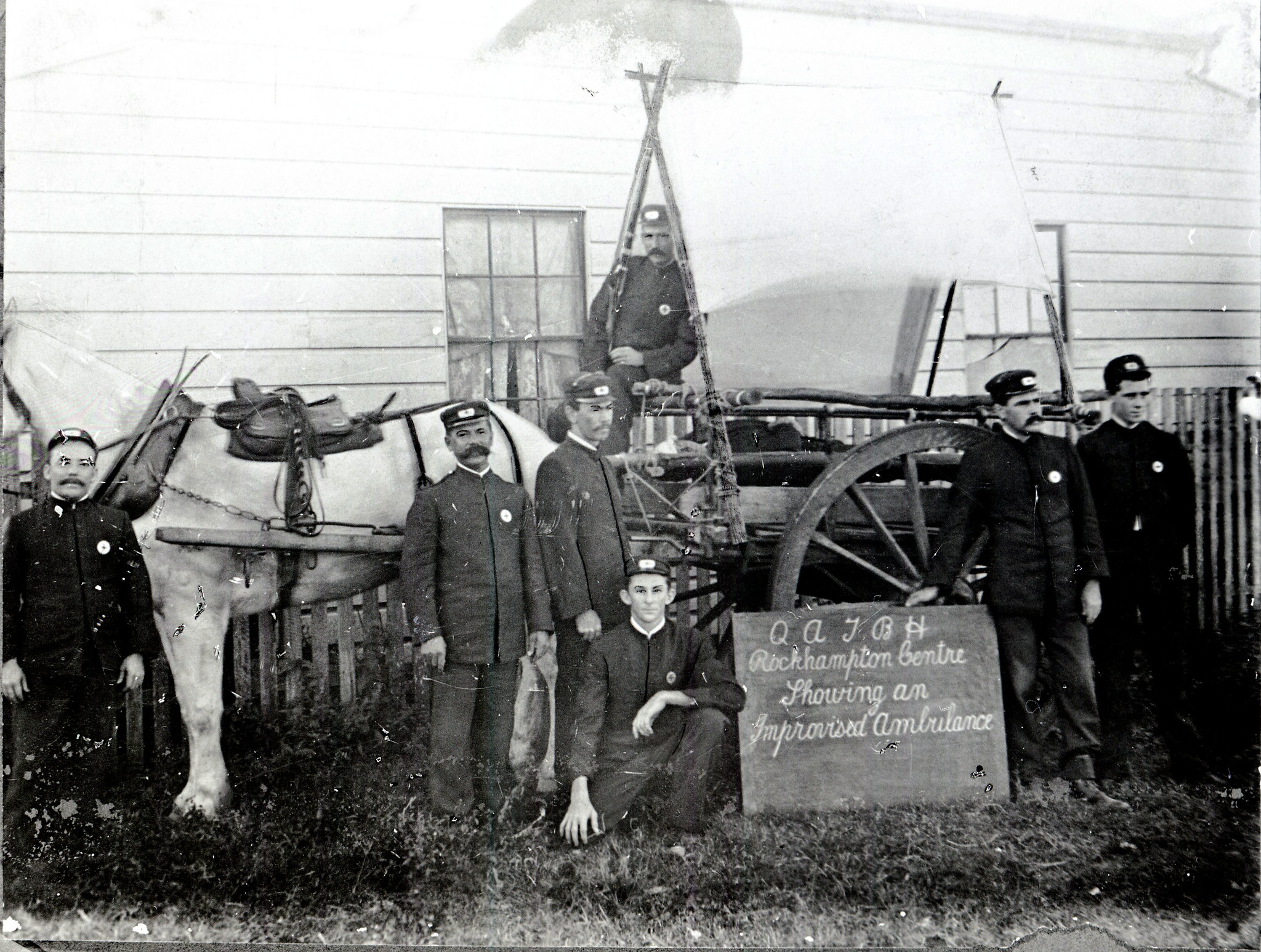
Rockhampton's Improvised Ambulance, circa 1901, QLD,
Queensland State Archives |
| Bullock on the loose in William Street, Rockhampton, Qld - early 1900s, Aussie~mobs |
 |
| Mr T Kift, a one-legged rider, who rode from Rockhampton to Sydney on a bicycle. Australian Town and Country Journal (Sydney, NSW : 1870 - 1919), Wednesday 20 July 1904 |
 |
EARLY ROCKHAMPTON ORCHESTRA.The Orpheus Club Orchestra, 1906. Reading from the left: Top row, Messrs T. P. Barrymore, H. Carter, E. N. Symons,C. Archer, D. W. Medcraf, G. H. Baker, F. Ward, G. F. Davis. Second row, Mr E. Stiller, Miss Holt, Mr W. G.Thompson, Mr W. H. Rudd (patron), Mr L. D'Hage (conductor), Miss Ballard, Mr Schmidt. Bottom row, Mr J. Carter, Miss Mollie Hourigan, Mr S. Maxwell, the Misses Holt and Mr D. Maxwell. Morning Bulletin (Rockhampton, Qld. : 1878 - 1954) |
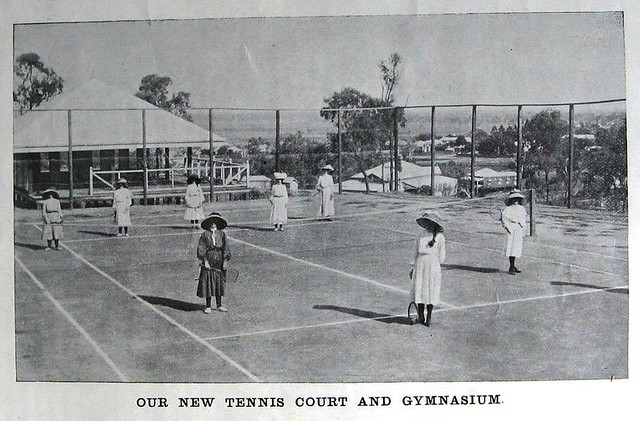 |
Our New Tennis Court and Gymnasium - The Convent, Rockhampton, Qld - 1907 Aussie~mobs
|
 |
| Cricket for Ladies is not new to . Rockhampton. — In 1907 .this team of Spinsters played a married ladies' team to raise funds for the Boys' Grammar School Sports Fund. Top row, Miss Price, Ogg, Power, E Buzacott; sitting. Misses J. Buzacott, Macpherson, Rees-Jones (captain), Harden, Dowling; front, Misses Rodgers and Martin. Central Queensland Herald (Rockhampton, Qld. : 1930 - 1956) |
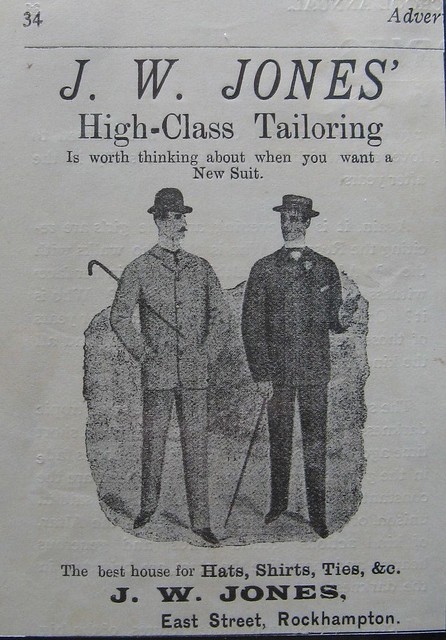 |
| J.W. Jones, Tailors - Rockhampton, Qld - 1907, Aussie~mobs |
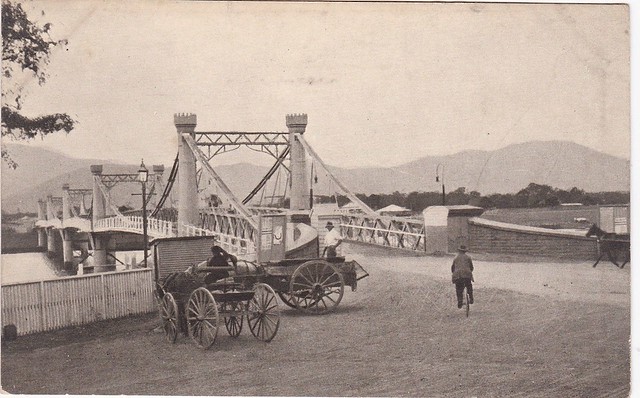 |
| Fitzroy Bridge, Rockhampton, Qld - early 1900s, Aussie~mobs |
 |
| Painting Class - The Convent, Rockhampton, Qld - 1907 Aussie~mobs |
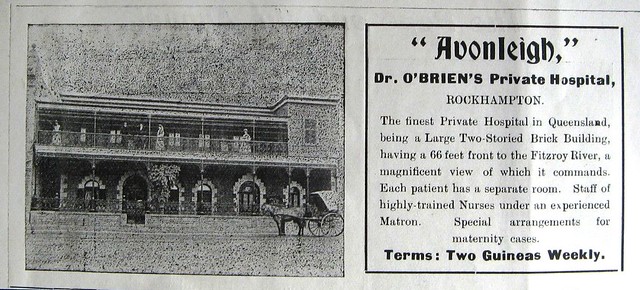 |
Avonleigh Private Hospital, Rockhampton, Qld - 1907 Aussie~mobs
|
 |
"City Coach Works - Rockhampton, Qld - 1907" by Aussie~mobs is licensed under CC PDM 1.0
|
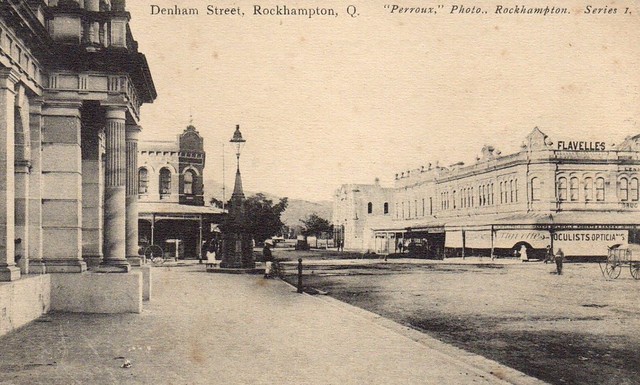
Postcard Denham Street Rockhampton, QLD, postmarked 20 Dec 1910
Aussie~mobs  |
| Stanley Street Railway Station, Rockhampton, Qld - circa 1910, Aussie~mobs |
 |
| Trams in East Street, Rockhampton, Qld - 1910, Aussie~mobs |
 |
| Show Ground Rockhampton, looking north, QLD, Week (Brisbane, Qld. : 1876 - 1934), Friday 16 June 1911 |
 |
| Rockhampton, QLD, shopfronts in 1917 |
 |
| The lower part of the city, looking towards The Range, during the 1918 flood, Rockhampton, QLD. Capricornian (Rockhampton, Qld. : 1875 - 1929) |
WWI
 |
| Col. Woolcock from Rockhampton, QLD, Queenslander (Brisbane, Qld. : 1866 - 1939), Saturday 15 September 1917 |
 |
| PRIVATE G. W. HARTLEY, son of Mrs. S. W. Hartley, Rockhampton. Died of wounds in France, June 23.Queenslander (Brisbane, Qld. : 1866 - 1939), Saturday 14 July 1917 |
Staff Nurse Elizabeth Parker, born Rockhampton, served at Lemnos in 1915.
More1920s |
| East Street in Rockhampton, Qld - 1920s, Aussie~mobs |
 |
| Passengers at the William Street railway station in Rockhampton with train leaving en route to Yeppoon ~1928, SLNSW |
1930s  |
| Passengers on the Park Avenue route bus, Rockhampton, QLD, circa 1930 |
 |
| WOORABINDA V. ROCKHAMPTON, QLD Morning Bulletin (Rockhampton, Qld. : 1878 - 1954), Tuesday 3 September 1935 |
 |
| Rockhampton street scenes, QLD, Central Queensland Herald (Rockhampton, Qld. : 1930 - 1956), Thursday 28 January 1937 |
 |
| Mickey Chapman of Eidsvold. At the Rockhampton Rodeo, QLD, Central Queensland Herald (Rockhampton, Qld. : 1930 - 1956), Thursday 21 September 1939 |
1940s and WWII
 |
| R.A.A.F. RECRUITS who left yesterday for a southern training depot.—Back row: R. V. Shiel (Mt Morgan), A. A. C. Larsen (The Caves), A. A.Henry (Monto), K. J. N. Effeney (Rockhampton), H. Freeman (Rockhampton), P. L. Reding (Rockhampton), H. J. McCann (Jambin), R. A. V. Edwards (Rockhampton). Middle row: R. M. Phillips (Rockhampton), E W. Chapman (Rockhampton), J. V. Pollitt (Rockhampton), H. P. Smith (Rockhampton), C. P. Buchholz (Monto), E. L. McLean (Rockhampton), W. Whitehead (Rockhampton). Front row: R. G. Tait (Sarina), R. D.Morrison (Rockhampton), C. D. P. Crew (Rockhampton), S. G. Scott (Rockhampton), W. W. McQuaker (Rockhampton), R. H. Tuck (Rockhampton). Morning Bulletin (Rockhampton, Qld. : 1878 - 1954), Saturday 15 June 1940 |
 |
| WOMEN'S NATIONAL EMERGENCY LEGION, ROCKHAMPTON, Receiving and dispatching a Morse code message at the Women's Emergency field, Central Queensland Herald (Rockhampton, Qld. : 1930 - 1956), Thursday 20 March 1941 |
 |
| Private N. H. Otto, third son of Mr and Mrs H. Otto, Nicholson Street, Rockhampton, who is serving with the A.I.F. abroad. Central Queensland Herald (Rockhampton, Qld. : 1930 - 1956), Thursday 11 December 1941 |
 |
| Oscar Munns, head stockman of Woorabinda Aboriginal settlement (right), and Joe Hegarty, head stockman of Cherbourg settlement, who, with other Aboriginal drovers, today reached Ipswich with 550 Hereford cattle bred on the two settlements. The trip from Woorabinda, west of Rockhampton, covered 450 miles, and was accomplished without any loss of slock. The cattle will he sold in Ipswich tomorrow. Telegraph (Brisbane, Qld. : 1872 - 1947), Thursday 30 March 1944 |
 |
The Chinese citizens of Rockhampton held a picnic at the Sandhills, Morning Bulletin (Rockhampton, Qld. : 1878 - 1954), Thursday 16 October 1947 |
 |
| A technician at work on the amplifier and regulator rack of the 12 -channel carrier telephone system which is being installed at the Rockhampton automatic telephone exchange. Central Queensland Herald (Rockhampton, Qld. : 1930 - 1956), Thursday 20 February 1947 |
 |
| 1947 & 1948: Advertisements in the Morning Bulletin (Rockhampton) More information |
|
1950s
 |
| Rockhampton Rodeo, QLD, Australian Women's Weekly (1933 - 1982), Wednesday 21 November 1951 |
 |
WOMEN SPECTATORS took advantage of Rockhampton's sunny rodeo weather and wore
bright smmmer cottons. Most of them came to cheer their menfolk. Many are expert horsewomen themselves, and they are keen critics of roughriding. Australian Women's Weekly (1933 - 1982), Wednesday 21 November 1951 |
 |
RODEO SPECTATORS. Party of four sitting on the fence to watch the Calf Roping Championship are, from left. Betty Kelly, of Forster, N.S.W.; Bunny Nolan, of Rockhampton; Laurel Burdekin, of Forster; and Pat Parker, of Rockhampton. Though amusing to watch, calf roping needs skill and judgment. Australian Women's Weekly (1933 - 1982), Wednesday 21 November 1951 |
 |
| At the Rockhampton Rodeo, QLD, Australian Women's Weekly (1933 - 1982), Wednesday 21 November 1951 |
 |
| East Street, Rockhampton, Qld - circa 1950s, Kaye |
 |
| The Great Western Hotel, Rockhampton, QLD. Morning Bulletin (Rockhampton, Qld. : 1878 - 1954), Saturday 27 June 1953 |
 |
| Rockhampton train station exterior - Rockhampton, 1955, QLD, Queensland State Archives |
1960s
 |
| Denison Street, Rockhampton, QLD, c 1968, The Sunlander was a long distance passenger train that operated between Brisbane and Cairns from 1953 to 2014. Queensland State Archives |
1970s
 |
| Four lane highway. Gladstone Road, Bruce Highway-147-10E-9 Bruce Highway [Benaraby-Rockhampton] Dept No.S03041, 1970s, Queensland State Archives |
 |
| Street in Rockhampton City, QLD. Sign Oxford Hotel National Mutual Central Region Dept No.S02732, c1973, Queensland State Archives |
 |
| East Street, Rockhampton, QLD, (1973), Queensland State Archives |
Sir Fergus McMaster
 |
| Sir Fergus McMaster (1879 – 1950) |
Sir Fergus McMaster (1879 – 1950), who was born at the gold mining town of Morinish, near Rockhampton, Queensland, was one of three founding members of Qantas (Queensland and Northern Territory Aerial Service). McMaster also served in WWI as a gunner with the 7th Battery, 3rd Brigade, Australian Field Artillery at Amiens, Villers-Bretonneux and Hamel. Initially, McMaster was rejected by the army on medical grounds and he only made it into the army on his fourth attempt.
Fergus McMaster was knighted in 1941 for his contribution to Australian aviation.
Beatrice Hutton
 |
| Beatrice May Hutton (1893–1990), also known as Bea Hutton |
Beatrice May Hutton (1893–1990), also known as Bea Hutton, was educated at Rockhampton Grammar School. She became the first female to be accepted into an institute of architects in Australia. The following buildings are some of her architectural projects:
J. W. Dalzell residence, Rockhampton (c. 1916)
Myles House, Rockhampton (c. 1919)
H Rudd house, Rockhampton (1923)
'Ngarita', Bellevue Hill, Sydney (1923)– attributed to architect James Vicars (Hutton’s uncle’s brother)
Brecknell Street, Rockhampton (1926)
NSW Masonic Club building (1927)
Sirius House, Macquarie Place
Around Rockhampton
.jpg) |
| Wiseman's Cottage is a heritage-listed storehouse built from 1857 to 1859, Rockhampton QLD |
 |
| Building at Rockhampton Heritage Village, QLD |
 |
| Building at Rockhampton Heritage Village, Rockhampton QLD |
 |
| "Sewella" named for Mary Ann Jane Sewell. at Canning Street Rockhampton QLD |
.jpg) |
| Rockhampton Girls Grammar School, Paterson House, circa 1892, Rockhampton QLD |
.jpg) |
| Rockhampton Regional Council's Town Hall was opened in 1941, Rockhampton QLD |
 |
| "Avonleigh" was built in 1885 in Colonial style for Frederick Morgan who started mining with his brothers at Mount Morgan in 1882, Rockhampton QLD |
 |
| The AMP Building, currently known as Brahman House, circa 1888, Rockhampton QLD |
.jpg) |
| "Shandon", was erected on Alma Street in 1892, Rockhampton QLD |
_Rockhampton_Campus%2C_from_Bolsover_Street_(2009).jpg) |
| Rockhampton Technical College, designed by Thomas Pye and built in 1914, Rockhampton QLD |
 |
| The Rockhampton School of Arts building was built in 1894, Rockhampton QLD |
.jpg) |
| Schotia Place, features twin cupolas and a barrel-vaulted roof, was opened on 18 April 1899, Rockhampton QLD |
.jpg) |
| North Rockhampton Borough Chambers is a heritage-listed former town hall built in 1885, Rockhampton QLD |
 |
| Archer Park Railway Museum was built from 1897 to 1908, Rockhampton QLD |
 |
| Criterion Hotel is a heritage-listed hotel built from 1889 to 1890 |
_(1996).jpg) |
| Rockhampton Post Office was built from 1892 to 1896, Rockhampton QLD |
.jpg) |
| Queensland National Bank Building was built in 1880, Rockhampton QLD |
 |
| ABC Radio Studios, constructed in 1897, as an administration office for the Mount Morgan Gold Mining Company, Rockhampton QLD |
.jpg) |
| "Killowen" built from 1898 to1920, is also known as Boland Residence, Rockhampton QLD |
.jpg) |
| "Clancholla" is a single storey, timber house constructed by 1922 in Ward Street, Rockhampton QLD |
 |
| "Lillianfel", built in 1896, Doctor John George Brown (more info), Rockhampton QLD |
.jpg) |
| Amla is a heritage-listed functionalist house built in 1952, Rockhampton QLD |
 |
| The Art Deco Swan Hotel building, located at 159 Denison St, Rockhampton QLD |
 |
| Rockhampton Courthouse. designed by John Hitch and built from 1950 to 1955, Rockhampton QLD |
.jpg) |
| The Rudd Residence at 248 Agnes Street, Rockhampton, Qld, circa 1923 |
 |
| Aboriginal painting from the Dreamtime Cultural Centre |
 |
| Glenmore Homestead circa 1859, near Rockhampton, QLD, In 1861, Glenmore Station, a cattle property covering 127 square miles, was purchased by the Birkbeck family. Samuel Birkbeck, who bought the property because of its proximity to the town of Rockhampton, arrived in Rockhampton after working as a mining engineer and manager of silver mines in Mexico. Birkbeck said of his purchase of Glenmore Station:".....the neighbourhood of Rockhampton which promises to be a good market; & the navigable river & general high opinion of the station etc. have induced me to determine on the purchase." |
Explore Rockhampton App
Rockhampton heritage buildings virtual tour of Quay Street
Archer Park Rail Museum
Dreamtime Cultural Centre
Central Queensland Military Museum
Rockhampton Heritage Village
History of Aboriginal Peoples from Dharumbal Country now known as Rockhampton By Wade Mann Presented by Janine Young
Rockhampton Residents 1889
The 5 ghost stories that still haunt Rockhampton
History Centre at the Rockhampton Regional Library
Earl’s Court, Rockhampton: A lost Art Deco cinema




















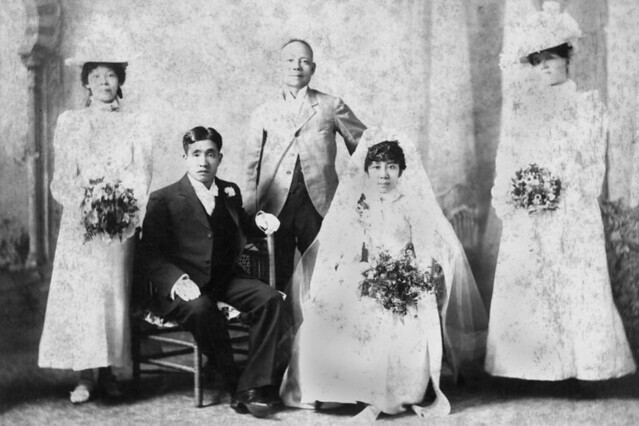




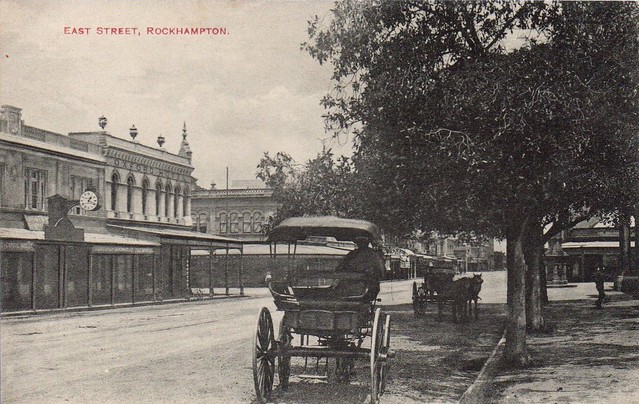




























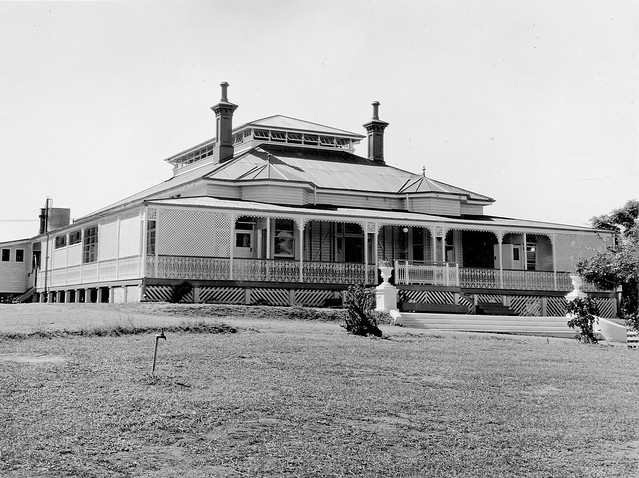




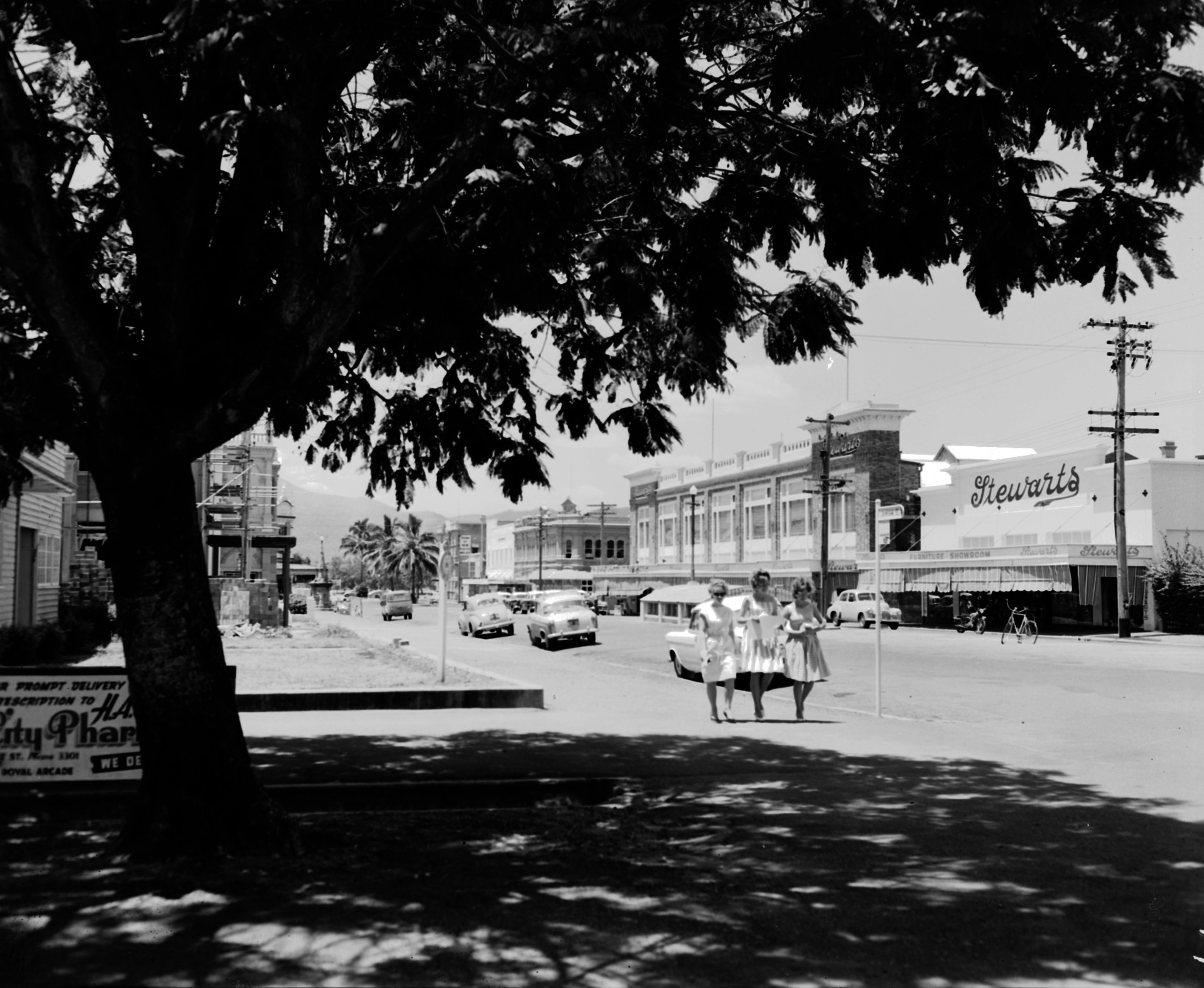







.jpg)



.jpg)
.jpg)


.jpg)
_Rockhampton_Campus%2C_from_Bolsover_Street_(2009).jpg)

.jpg)
.jpg)

_(1996).jpg)
.jpg)

.jpg)
.jpg)

.jpg)


.jpg)















